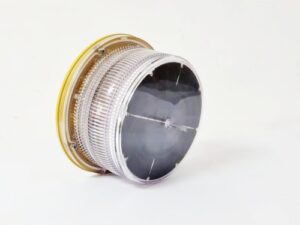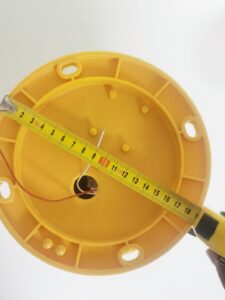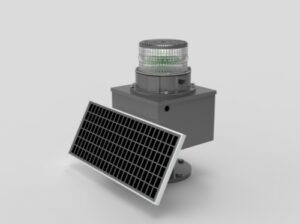Introduction: The Importance of Components
When it comes to aviation obstruction lights, each component plays a pivotal role in ensuring safety, durability, and efficiency. Understanding the intricacies of these components can significantly enhance the performance and longevity of your lighting solutions.
So, let’s dissect the anatomy of aviation obstruction lights and explore the key elements that make them indispensable for aviation safety.
Lens: The Eye of the Light

The lens serves as the eye of the light, a critical component made from high-quality polycarbonate. It employs convex principles to focus and amplify emitted light, ensuring long-distance visibility in both aviation and marine settings. However, it’s essential for B2B buyers to understand that this high-quality material is not without its challenges. Polycarbonate lenses can yellow over time due to various factors such as UV exposure and environmental conditions. This yellowing can compromise both visibility and compliance with international standards.Fortunately, measures such as applying specialized UV-protective coatings and avoiding the admixture of any other substances can ensure the lens maintains high transparency, doesn’t yellow, and is UV-resistant. Many suppliers, in pursuit of higher profits, may even use recycled plastics. Therefore, it’s crucial to exercise caution and make thorough comparisons when selecting a supplier.
LED: The Heartbeat of Illumination
The LED serves as the heartbeat of the light, providing stable and low-decay illumination. Brands like Osram and Philips are often the go-to choices for their reliability and longevity, making them ideal for continuous, long-term operation.

PCB: The Nerve Center

The Printed Circuit Board (PCB) is the nerve center of the light, directing electrical flow and LED functions. Advanced PCBs integrate features like automatic day-night operation and wireless synchronization, eliminating the need for additional control units.
Solar Panel: The Powerhouse

The solar panel is responsible for capturing and converting solar energy into electrical power, which is then stored in the battery for use during periods without sunlight. Panels can be integrated into the lens or externally mounted, with waterproof ratings varying accordingly. It’s essential for buyers to understand that not all solar panels are created equal. They can be made from monocrystalline or polycrystalline silicon, with the former offering higher energy efficiency but at a higher cost. Additionally, the quality of the solar cells, whether they are cut from whole wafers or are fragmented, also impacts the panel’s efficiency. Achieving maximum power output within the limited space of the lens requires meticulous attention to the material and craftsmanship of the solar cells. Therefore, it’s crucial to consider these factors when evaluating suppliers.
Storage Battery: The Energy Reservoir

The storage battery serves as the energy reservoir, ensuring the light’s continuous operation, particularly when the solar panel is not generating power. Various types of batteries are available, including AGM Lead Acid, Nickel-Metal, Lithium-Ion, and LiFePO4, each with its unique advantages and limitations.
AGM Lead Acid batteries are bulky and offer lower capacity in limited spaces, with a discharge depth of 60% and a lifespan of 3-5 years. Nickel-Metal batteries are more compact but generally do not exceed a 5-year lifespan.
In contrast, Lithium-Ion batteries, particularly LiFePO4 types, are increasingly popular due to their high energy density, lightweight, and compact size. While LiFePO4 batteries are the most expensive, their 6000-cycle Depth of Discharge (DOD) ensures a lifespan of over ten years for the light fixture. They are the go-to choice unless operating in extremely low temperatures, where ternary lithium batteries with thermal insulation may serve as an alternative. Ternary lithium batteries offer a DOD of around 500 cycles.
Given these considerations, it’s crucial for buyers to carefully evaluate the battery types that best meet their specific needs and operational conditions.
Conclusion
Understanding the components of aviation obstruction lights is crucial for making an informed purchase. From the lens to the storage battery, each element has a specific role and contributes to the overall performance and safety of the light. Always opt for high-quality components from trusted suppliers to ensure the longevity and effectiveness of your aviation obstruction lights.





